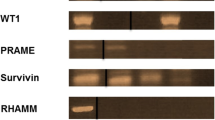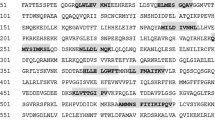Abstract
Human T cell leukemia virus type 1 (HTLV-1) induced adult T cell leukemia/lymphoma (ATLL) is usually a fatal lymphoproliferative malignant disease. Thus, the enhancement of T cell immunity to ATLL through the development of therapeutic vaccines using characterized T cell peptide epitopes could be of value. We isolated and characterized HLA-DR-bound peptides from HTLV-1-transformed T cells by fractionating on reverse-phase high performance liquid chromatography and Edman NH2-terminal sequencing and were able to identify five independent peptide sequences. One of the identified peptide sequences corresponded to a fragment of the human interleukin-9 receptor alpha (IL-9Rα), which is commonly expressed by HTLV-1-infected T cell lymphoma cells. Using a synthetic peptide corresponding to the identified IL-9Rα sequence, we generated antigen-specific CD4 helper T lymphocytes in vitro, which were restricted by HLA-DR15 or HLA-DR53 molecules and could recognize and kill HTLV-1+, IL-9Rα+ T cell lymphoma cells. These results indicate that IL-9Rα functions as T cell leukemia/lymphoma-associated antigen for CD4 T cells and that synthetic peptides such as the one described here could be used for T cell-based immunotherapy against IL-9Rα positive ATLL.








Similar content being viewed by others
References
Ball ED, Broome HE (2010) Monoclonal antibodies in the treatment of hematologic malignancy. Best Pract Res Clin Haematol 23:403–416
Barata JT, Keenan TD, Silva A, Nadler LM, Boussiotis VA, Cardoso AA (2004) Common gamma chain-signaling cytokines promote proliferation of T-cell acute lymphoblastic leukemia. Haematologica 89:1459–1467
Chen J, Petrus M, Bryant BR, Nguyen VP, Goldman CK, Bamford R, Morris JC, Janik JE, Waldmann TA (2011) Autocrine/paracrine cytokine stimulation of leukemic cell proliferation in smoldering and chronic adult T-cell leukemia. Blood 116:5948–5956
Chung HK, Young HA, Goon PK, Heidecker G, Princler GL, Shimozato O, Taylor GP, Bangham CR, Derse D (2003) Activation of interleukin-13 expression in T cells from HTLV-1-infected individuals and in chronically infected cell lines. Blood 102:4130–4136
Demoulin JB, Renauld JC (1998) Interleukin 9 and its receptor: an overview of structure and function. Int Rev Immunol 16:345–364
Ferrando AA, Neuberg DS, Staunton J, Loh ML, Huard C, Raimondi SC, Behm FG, Pui CH, Downing JR, Gilliland DG, Lander ES, Golub TR, Look AT (2002) Gene expression signatures define novel oncogenic pathways in T cell acute lymphoblastic leukemia. Cancer Cell 1:75–87
Fischer M, Bijman M, Molin D, Cormont F, Uyttenhove C, van Snick J, Sundstrom C, Enblad G, Nilsson G (2003) Increased serum levels of interleukin-9 correlate to negative prognostic factors in Hodgkin’s lymphoma. Leukemia 17:2513–2516
Fridkis-Hareli M, Teitelbaum D, Gurevich E, Pecht I, Brautbar C, Kwon OJ, Brenner T, Arnon R, Sela M (1994) Direct binding of myelin basic protein and synthetic copolymer 1 to class II major histocompatibility complex molecules on living antigen-presenting cells—specificity and promiscuity. Proc Natl Acad Sci USA 91:4872–4876
Futaki G, Kobayashi H, Sato K, Taneichi M, Katagiri M (1995) Naturally processed HLA-DR9/DR53 (DRB1*0901/DRB4*0101)-bound peptides. Immunogenetics 42:299–301
Giuntoli RL II, Lu J, Kobayashi H, Kennedy R, Celis E (2002) Direct costimulation of tumor-reactive CTL by helper T cells potentiate their proliferation, survival, and effector function. Clin Cancer Res 8:922–931
Gokbuget N, Hoelzer D (2004) Treatment with monoclonal antibodies in acute lymphoblastic leukemia: current knowledge and future prospects. Ann Hematol 83:201–205
Goswami R, Kaplan MH (2011) A brief history of IL-9. J Immunol 186:3283–3288
Halder T, Pawelec G, Kirkin AF, Zeuthen J, Meyer HE, Kun L, Kalbacher H (1997) Isolation of novel HLA-DR restricted potential tumor-associated antigens from the melanoma cell line FM3. Cancer Res 57:3238–3244
Hayashi S, Kumai T, Matsuda Y, Aoki N, Sato K, Kimura S, Kitada M, Tateno M, Celis E, Kobayashi H (2011) Six-transmembrane epithelial antigen of the prostate and enhancer of zeste homolog 2 as immunotherapeutic targets for lung cancer. J Transl Med 9:191
Kawahara M, Hori T, Matsubara Y, Okawa K, Uchiyama T (2006) Identification of HLA class I-restricted tumor-associated antigens in adult T cell leukemia cells by mass spectrometric analysis. Exp Hematol 34:1496–1504
Kobayashi H, Celis E (2008) Peptide epitope identification for tumor-reactive CD4 T cells. Curr Opin Immunol 20:221–227
Kobayashi H, Nagato T, Takahara M, Sato K, Kimura S, Aoki N, Azumi M, Tateno M, Harabuchi Y, Celis E (2008) Induction of EBV-latent membrane protein 1-specific MHC class II-restricted T-cell responses against natural killer lymphoma cells. Cancer Res 68:901–908
Kobayashi H, Wood M, Song Y, Appella E, Celis E (2000) Defining promiscuous MHC class II helper T-cell epitopes for the HER2/neu tumor antigen. Cancer Res 60:5228–5236
Kubota S, Siomi H, Hatanaka M, Pomerantz RJ (1996) Cis/trans-activation of the interleukin-9 receptor gene in an HTLV-I-transformed human lymphocytic cell. Oncogene 12:1441–1447
Matsushita K, Arima N, Ohtsubo H, Fujiwara H, Hidaka S, Fukumori J, Tanaka H (1997) Frequent expression of interleukin-9 mRNA and infrequent involvement of interleukin-9 in proliferation of primary adult T-cell leukemia cells and HTLV-I infected T-cell lines. Leuk Res 21:211–216
Matsuzawa S, Sakashita K, Kinoshita T, Ito S, Yamashita T, Koike K (2003) IL-9 enhances the growth of human mast cell progenitors under stimulation with stem cell factor. J Immunol 170:3461–3467
Merz H, Houssiau FA, Orscheschek K, Renauld JC, Fliedner A, Herin M, Noel H, Kadin M, Mueller-Hermelink HK, Van Snick J et al (1991) Interleukin-9 expression in human malignant lymphomas: unique association with Hodgkin’s disease and large cell anaplastic lymphoma. Blood 78:1311–1317
Miyoshi I, Kubonishi I, Yoshimoto S, Akagi T, Ohtsuki Y, Shiraishi Y, Nagata K, Hinuma Y (1981) Type C virus particles in a cord T-cell line derived by co-cultivating normal human cord leukocytes and human leukaemic T cells. Nature 294:770–771
Nagato T, Kobayashi H, Kishibe K, Takahara M, Ogino T, Ishii H, Oikawa K, Aoki N, Sato K, Kimura S, Shimizu N, Tateno M, Harabuchi Y (2005) Expression of interleukin-9 in nasal natural killer/T-cell lymphoma cell lines and patients. Clin Cancer Res 11:8250–8257
Omiya R, Buteau C, Kobayashi H, Paya CV, Celis E (2002) Inhibition of EBV-induced lymphoproliferation by CD4(+) T cells specific for an MHC class II promiscuous epitope. J Immunol 169:2172–2179
Qiu L, Lai R, Lin Q, Lau E, Thomazy DM, Calame D, Ford RJ, Kwak LW, Kirken RA, Amin HM (2006) Autocrine release of interleukin-9 promotes Jak3-dependent survival of ALK+ anaplastic large-cell lymphoma cells. Blood 108:2407–2415
Rohn TA, Reitz A, Paschen A, Nguyen XD, Schadendorf D, Vogt AB, Kropshofer H (2005) A novel strategy for the discovery of MHC class II-restricted tumor antigens: identification of a melanotransferrin helper T-cell epitope. Cancer Res 65:10068–10078
Uyttenhove C, Simpson RJ, Van Snick J (1988) Functional and structural characterization of P40, a mouse glycoprotein with T-cell growth factor activity. Proc Natl Acad Sci USA 85:6934–6938
Wang RF, Wang X, Atwood AC, Topalian SL, Rosenberg SA (1999) Cloning genes encoding MHC class II-restricted antigens: mutated CDC27 as a tumor antigen. Science 284:1351–1354
Conflict of interest
The authors declare no conflict of interest.
Author information
Authors and Affiliations
Corresponding authors
Additional information
Hiroya Kobayashi and Takumi Kumai contributed equally to this work.
Rights and permissions
About this article
Cite this article
Kobayashi, H., Kumai, T., Hayashi, S. et al. A naturally processed HLA-DR-bound peptide from the IL-9 receptor alpha of HTLV-1-transformed T cells serves as a T helper epitope. Cancer Immunol Immunother 61, 2215–2225 (2012). https://doi.org/10.1007/s00262-012-1284-7
Received:
Accepted:
Published:
Issue Date:
DOI: https://doi.org/10.1007/s00262-012-1284-7




